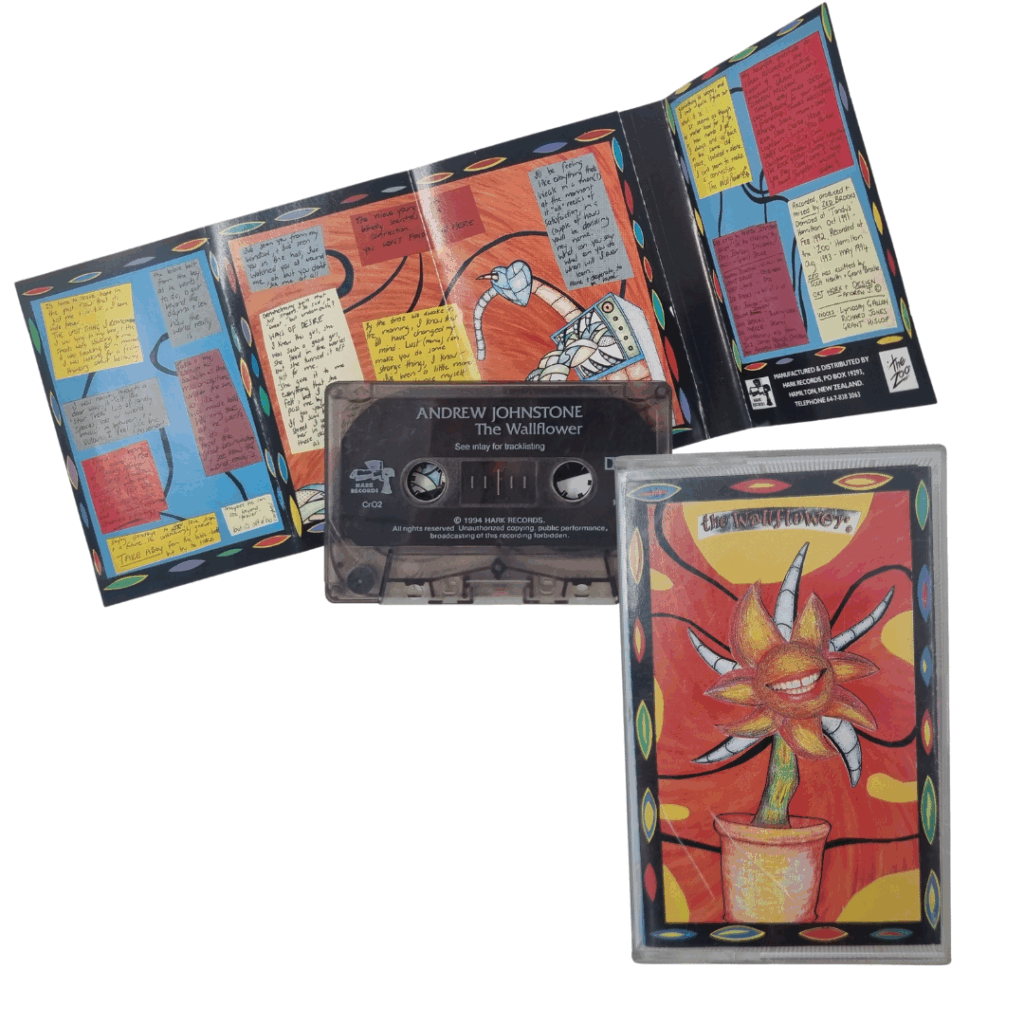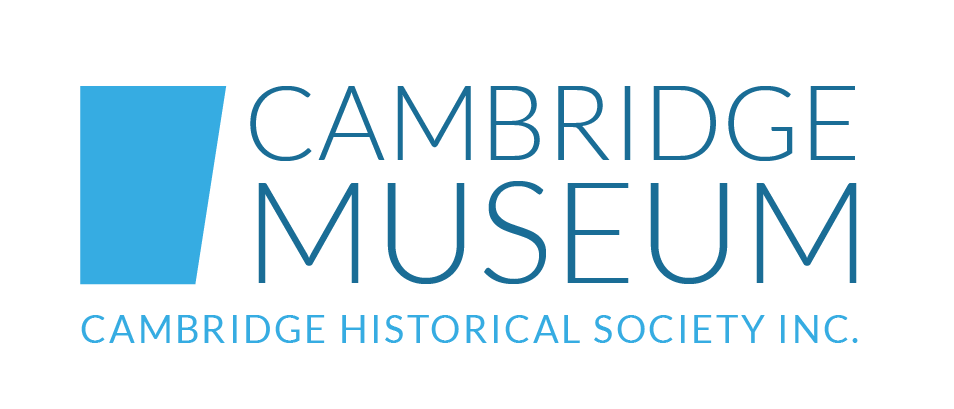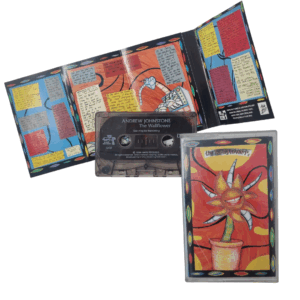
The Wallflower Audio Tape
-
How We Made The Wallflower, ‘an electronic, country, sci-fi concept album’.
by Andrew Johnstone
In 1991, Zed Brooks and I set about creating a concept album, a project that started out simply enough but quickly took on a life of its own. A scene within a scene, The Wallflower took almost 4 years to complete and became something of a legend, at least to the people in the know.
I sent former Monkee and Country Rock pioneer Mike Nesmith a fan letter when I was 15 and he sent me a copy of his 1974 album The Prison. A Book with a Soundtrack. It was a revelation and changed the way I thought about music. Fired up I became fixated on the potential of the concept album to express thoughts, feelings and ideas and decided to make one of my own some day.
Fifeteen years later I set to it. The Wallflower took a year to write and two versions of the album were recorded between 1991 and 1994. The second version was released in 1995. It sold 250 copies.
When the label that financed the second version of the album went into liquidation, I thought the album was lost for good and while the master tapes have vanished, some cassette copies survive, one of which is in the Cambridge Museum collection.
These MP3s were lifted from a cassette version of the album.
The Wallflower Part One (October 1991- February 1992).
The Wallflower was recorded, produced, and mixed by Zed Brooks at Tandy’s Recording Studio on Morrinsville Road, written by Andrew Johnstone except ‘In the Morning’ written by Chris ‘Fish’ Johnson.
In popular culture the word wallflower refers to an individual left behind on the playing field of romance and in more recent times has become a figure of speech used to describe a ‘loner’. The Wallflower is a satire about teenage angst.
I imagined an album that was a little like a Ken Russell movie, a crazed dream fever laced with religious and sexual imagery. In fact I went so far with the Ken Russell thing that I copied in dialogue from his 1984 film ‘Crimes of Passion’ starring Anthony Perkins and Kathleen Turner. The albums opening track ‘Love Injection’ begins with a line from the film: “Here, have a Quaalude, to float, you float I promise, remember, I never lie.”
The Recording
Acoustic versions of the songs were recorded with the instrumentation and vocals added later. Money was short and time was at a premium so everything was done quickly. The spoken word samples were recorded by a cassette player set in front of a TV and dialogue from Star Trek- The Original Series, two Ken Russell films, TV Soaps and talk shows. The horns in the chorus of Billy Mumy’s Lament were lifted from a vintage 78rpm jazz record.
The Players:
Zed Brooks (Step Chant Unit, Schrödinger’s cat, Wonderbug, MooFish) – Bass, Keyboards, and Guitar
Grant Brodie (Inspector Moog, Dribbly Cat Attraction) – Keyboards, Accordion
Andrew johnstone – Vocals, Rhythm Guitar
Rhonda Hoffmans – Vocals and Backing Vocals
Sooz Brown – Vocals and Backing Vocals
Bass: Jeff Lamb
Guitars: Chris Johnson
Drums: Bill Parker (Blackjack)
I had no plans to release it.
The Wallflower Part Two: The Zoo August 1993-May 1994 (Hark Records)
In 1992 Zed left Tandys and built The Zoo, NZ’s first digital studio. It was conceived by The Rock and the Edge founder Grant Hislop to feed his label Hark Records. Zed passed a copy of The Wallflower to Grant who proposed rerecording it at The Zoo. The idea was to create a more polished version for Hark Records. It was engineered by Zed Brooks and Grant Brodie and produced by Zed Brooks. Cover Art: Andrew Johnstone
The Players:
Andrew Johnstone – Vocals and Rhythm Guitar
Chris Fish – Lead Guitar
Daniel Devcich – Bass
Christian Pearce – Drums
Bill Parker – Drums
Grant Brodie – Keyboards and Accordion.
Zed Brookes – A Bit Of Anything and Everything
Grant Hislop, Lindsay Gallon, and Richard Jones – Narration (It was too expensive to chase copyright for the sampled dialogue so we used voice actors)
A video was shot for Billy Mumy’s Lament by filmmaker Steve Clarke,. Reminiscent of Ingmar Bergman, it was filmed at the bottom of the opencast mine at Rotowaro.
Two tracks later featured on a Hark promotional CD called Bark: ‘Wings of Love’ and ‘Hell was my Destination’.
Here are a few words from Zed Brookes and Grant Brodie about the project.
Zed Brookes
Over my many years of engineering and production, this album is probably the one that I most strongly identify with. Although it’s Andrew’s solo album, it really ended up as a collaborative project as it went from Andrew’s acoustic guitar demos (some of which still ended up in the final album) to a vastly more complex production. It began as a bunch of acoustic demos by Andrew recorded on an old Fostex analogue 16-track reel-to-reel in the converted barn at Tandy’s studio in Hamilton and ended up as a full analogue/digital production at the Zoo studios a few years later.
It was a sort of a quirky dark electronic country sci-fi concept album that was probably a little ahead of its time. We spent a lot of time over the few years of working on finding each song’s unique character and bringing it to life. There were versions of almost every song that were wiped and started again from scratch, and as with most albums there were more songs recorded than those included.
As the album slowly developed, we brought in guest musicians; drummers, bass players, guitarists, keyboard players, violinists and singers at various times as we explored the many possible dimensions of each song, and towards the end of the project most of my early electronic drums/rhythms were replaced with real drums to give it all a bit more grit and counteract the extra samples and synths somewhat.
I’m pretty pleased that we still managed to keep some of my own bass/guitar/keyboard playing in there as well. This was all done in the early days of comparatively low-budget (i.e. less than a million dollars) digital technology, and there was no Pro Tools or other affordable computer-based editing technology – apart from an Akai S900 sampler (plus a vintage 8-bit Ensoniq Mirage with one dodgy voice!) and an Atari with Notator for the MIDI parts. A lot of the guest parts were re-arranged and re-sculpted using the sampler from what were often single (usually the first) takes on each song to capture that magic authentic vibe from the musos.
The early versions of the album also had cool obscure samples from the original Star Trek series in it, but it turned out to be too expensive to license them, so we just did our own similar parts instead. Overall this album is one of the ones I’m most proud of. There are so many layers of detail in every song – even the simpler-sounding ones – that you’ll probably never hear it all, and for myself, every song has it’s own rich back-story.
* After the closure of The Zoo in 1997, Zed taught audio and songwriting at Waikato Polytechnic (WINTEC) while completing a Graduate Certificate in Music and Film Sound from Griffith University (Queensland). After moving to Auckland a while later he did some production work at Mai FM/Mai music while teaching part time at MAINZ. He now teaches Audio Engineering full time at MAINZ.
Grant Brodie
It is hard to separate working at The Zoo (where I was second engineer and apprenticed to Zed) and recording Wallflower, a project that took up much of our time. Dispersed with that was the odd bit keyboard playing. From memory most of the keyboards were recorded in one session when we went from one song to the next quite quickly. We were pretty well rehearsed at that point so I don’t think it was all that hard. I remember Zed fixed a lot of my sloppy playing with the midi editor (Atari ST, I think).
We recorded everything via midi so if we got a great take but with a couple of fumbles we could fix them up. I remember Zed spend a lot of time on the album and I can remember staying late with him watching him mix. It was a really good experience for me because I got to participate in the process of making an album from start to finish.
My overall memory of the project was the great melodic songs and it amazed me how Zed brought those songs to life, honing in on what was important for each of them. I am proud of that album and pleased to have been involved.
* Grant stayed on with MediaWorks, the media conglomerate that evolved from The Rock and The Edge. He is now MediaWorks Group Imaging Manager and personally looks after The Rock and The Edge. He has been with the company for some 25 years.

